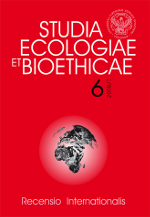Makroszczątki roślinne w torfie w analizie paleośrodowiskowych uwarunkowań osadnictwa na przykładzie stanowiska Łane Małe w dolinie Kłodnicy
Peat macrofossils in the analysis of palaeoenvironmental conditions of settlement; the case of Łany Małe site in the Kłodnica valley
Author(s): Krzysztof Wójcicki, Marek KlossSubject(s): Archaeology, Environmental Geography
Published by: Wydawnictwo Naukowe Uniwersytetu Kardynała Stefana Wyszyńskiego w Warszawie
Summary/Abstract: Results of archaeological studies from the territory of Poland show that prehistorical settlements were often founded on the banks of lakes and mires. Botanical composition of organic deposits allows reconstructing historical plant communities and palaeohydrological conditions of the settlement, the subject of research was a peatland situated in the neighborhood of the archaeological site at Łany Małe. The latter is located on hillslopes of the Kłodnica valley (Upper Silesia, southern Poland). Peat formation at the Łany Małe site took place in the Pre-Boreal Period as an effect of the valley floor paludification. In the Mesolithic and Neolithic Periods as well as the Early Bronze Age, swampy alder forests occupied the entire area of the peatland. At that time, the fen surface was relatively easily accessible for humans, especially for people of the Funnel Beaker Culture in the Middle Neolithic Period. It was then when, probably, the ground water level dropped down and peat decay processes took over those of peat production. In the Hallstatt Period, during the presence of the Lusatian Culture settlement, there was subsequent increase in biotope moisture. Forest communities became more open and trees were gradually displaced by grasslike plants, especially of sedge (Carex) genus. In the Fate Roman Period (the Przeworsk Culture settlement) and in the early Middle Ages, the peatland was subject to inundation due to frequent flooding, the peat accumulation was then halted by the delivery of fine-grained products of soil erosion.
Journal: Studia Ecologiae et Bioethicae
- Issue Year: 6/2008
- Issue No: 1
- Page Range: 449-460
- Page Count: 12
- Language: Polish

